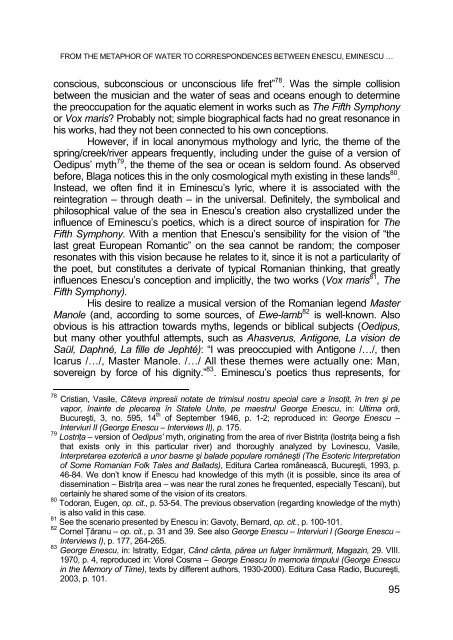musica - Studia
musica - Studia
musica - Studia
You also want an ePaper? Increase the reach of your titles
YUMPU automatically turns print PDFs into web optimized ePapers that Google loves.
FROM THE METAPHOR OF WATER TO CORRESPONDENCES BETWEEN ENESCU, EMINESCU …<br />
conscious, subconscious or unconscious life fret” 78 . Was the simple collision<br />
between the musician and the water of seas and oceans enough to determine<br />
the preoccupation for the aquatic element in works such as The Fifth Symphony<br />
or Vox maris? Probably not; simple biographical facts had no great resonance in<br />
his works, had they not been connected to his own conceptions.<br />
However, if in local anonymous mythology and lyric, the theme of the<br />
spring/creek/river appears frequently, including under the guise of a version of<br />
Oedipus’ myth 79 , the theme of the sea or ocean is seldom found. As observed<br />
before, Blaga notices this in the only cosmological myth existing in these lands 80 .<br />
Instead, we often find it in Eminescu’s lyric, where it is associated with the<br />
reintegration – through death – in the universal. Definitely, the symbolical and<br />
philosophical value of the sea in Enescu’s creation also crystallized under the<br />
influence of Eminescu’s poetics, which is a direct source of inspiration for The<br />
Fifth Symphony. With a mention that Enescu’s sensibility for the vision of “the<br />
last great European Romantic” on the sea cannot be random; the composer<br />
resonates with this vision because he relates to it, since it is not a particularity of<br />
the poet, but constitutes a derivate of typical Romanian thinking, that greatly<br />
influences Enescu’s conception and implicitly, the two works (Vox maris 81 , The<br />
Fifth Symphony).<br />
His desire to realize a <strong>musica</strong>l version of the Romanian legend Master<br />
Manole (and, according to some sources, of Ewe-lamb 82 is well-known. Also<br />
obvious is his attraction towards myths, legends or biblical subjects (Oedipus,<br />
but many other youthful attempts, such as Ahasverus, Antigone, La vision de<br />
Saül, Daphné, La fille de Jephté): “I was preoccupied with Antigone /…/, then<br />
Icarus /…/, Master Manole. /…/ All these themes were actually one: Man,<br />
sovereign by force of his dignity.” 83 . Eminescu’s poetics thus represents, for<br />
78 Cristian, Vasile, Câteva impresii notate de trimisul nostru special care a însoţit, în tren şi pe<br />
vapor, înainte de plecarea în Statele Unite, pe maestrul George Enescu, in: Ultima oră,<br />
Bucureşti, 3, no. 595, 14 th of September 1946, p. 1-2; reproduced in: George Enescu –<br />
Interviuri II (George Enescu – Interviews II), p. 175.<br />
79 Lostriţa – version of Oedipus’ myth, originating from the area of river Bistriţa (lostriţa being a fish<br />
that exists only in this particular river) and thoroughly analyzed by Lovinescu, Vasile,<br />
Interpretarea ezoterică a unor basme şi balade populare româneşti (The Esoteric Interpretation<br />
of Some Romanian Folk Tales and Ballads), Editura Cartea românească, Bucureşti, 1993, p.<br />
46-84. We don’t know if Enescu had knowledge of this myth (it is possible, since its area of<br />
dissemination – Bistriţa area – was near the rural zones he frequented, especially Tescani), but<br />
certainly he shared some of the vision of its creators.<br />
80 Todoran, Eugen, op. cit., p. 53-54. The previous observation (regarding knowledge of the myth)<br />
is also valid in this case.<br />
81 See the scenario presented by Enescu in: Gavoty, Bernard, op. cit., p. 100-101.<br />
82 Cornel Ţăranu – op. cit., p. 31 and 39. See also George Enescu – Interviuri I (George Enescu –<br />
Interviews I), p. 177, 264-265.<br />
83 George Enescu, in: Istratty, Edgar, Când cânta, părea un fulger înmărmurit, Magazin, 29. VIII.<br />
1970, p. 4, reproduced in: Viorel Cosma – George Enescu în memoria timpului (George Enescu<br />
in the Memory of Time), texts by different authors, 1930-2000). Editura Casa Radio, Bucureşti,<br />
2003, p. 101.<br />
95

















